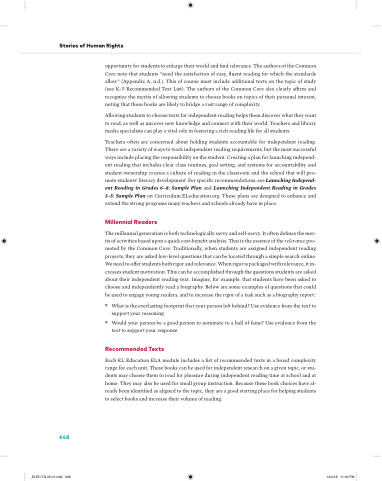Page 672 - EL Grade 5 Teacher Guide
P. 672
Stories of Human Rights
opportunity for students to enlarge their world and nd relevance. The authors of the Common Core note that students “need the satisfaction of easy, uent reading for which the standards allow” (Appendix A, n.d.). This of course must include additional texts on the topic of study (see K–5 Recommended Text List). The authors of the Common Core also clearly a rm and recognize the merits of allowing students to choose books on topics of their personal interest, noting that those books are likely to bridge a vast range of complexity.
Allowing students to choose texts for independent reading helps them discover what they want to read, as well as uncover new knowledge and connect with their world. Teachers and library media specialists can play a vital role in fostering a rich reading life for all students.
Teachers often are concerned about holding students accountable for independent reading. There are a variety of ways to track independent reading requirements, but the most successful ways include placing the responsibility on the student. Creating a plan for launching independ- ent reading that includes clear class routines, goal setting, and systems for accountability and student ownership creates a culture of reading in the classroom and the school that will pro- mote students’ literacy development. For speci c recommendations, see Launching Independ- ent Reading in Grades 6–8: Sample Plan and Launching Independent Reading in Grades 3–5: Sample Plan on Curriculum.ELeducation.org. These plans are designed to enhance and extend the strong programs many teachers and schools already have in place.
Millennial Readers
The millennial generation is both technologically savvy and self-savvy. It often de nes the mer- its of activities based upon a quick cost-bene t analysis. That is the essence of the relevance pro- moted by the Common Core. Traditionally, when students are assigned independent reading projects, they are asked low-level questions that can be located through a simple search online. We need to o er students both rigor and relevance. When rigor is packaged with relevance, it in- creases student motivation. This can be accomplished through the questions students are asked about their independent reading text. Imagine, for example, that students have been asked to choose and independently read a biography. Below are some examples of questions that could be used to engage young readers, and to increase the rigor of a task such as a biography report:
■ What is the everlasting footprint that your person left behind? Use evidence from the text to support your reasoning.
■ Would your person be a good person to nominate to a hall of fame? Use evidence from the text to support your response.
Recommended Texts
Each EL Education ELA module includes a list of recommended texts in a broad complexity range for each unit. These books can be used for independent research on a given topic, or stu- dents may choose them to read for pleasure during independent reading time at school and at home. They may also be used for small group instruction. Because these book choices have al- ready been identi ed as aligned to the topic, they are a good starting place for helping students to select books and increase their volume of reading.
648
_ELED.TG.05.01.indb 648
12/4/18 11:49 PM


